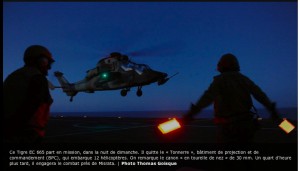2012-07-23 In this piece translated from the French. General Patrick Tanguy one of the architects of modern Army aviation con-ops discusses the modern air mobility concept relied upon by the French forces, and highlighted in Libyan and Afghan operations. General Tanguy is on the editorial board of our partner publication SOUTIEN, LOGISTIQUE,DEFENSE which is entering its fourth year of publication.
By Patrick Tanguy, Général de division (2S) (Ret.)
A few simple words that capture the essence of the 21st century of the French Army Light Aviation (ALAT) are: Break from the past, continuity and efficiency. There has been a departure from the past due to the ALAT’s environment, resources, organization and mode of operation which have undergone an extensive transformation in a very short period of time. Yet while there has been a break from the past, this evolution has benefitted from maintaining continuity at the same time.
The French Army Light Aviation (French: Aviation Légère de l’Armée de Terre, ALAT, literally Light Aviation of the Land Army) is the Army aviation service of the French Army. ALAT was established on 22 November 1954 for observation, reconnaissance, assault and supply duties. Since its creation in 1954, it has participated in almost all French military engagements and humanitarian aid deployments including the French Indochina War, the Algerian War, the Persian Gulf War of 1990-91, the Lebanese conflict, the war in Chad, the independence of Djibout, the war in Somalia, operations in Bosnia-Herzegovina, the Kosovo War, the Indonesian occupation of East Timor, the Operation Licorne in Cote d’Ivoire, the humanitarian response to the December 2004 Indian Ocean earthquake and tsunami, the War in Afghanistan, and the 2011 military intervention in Libya.
The ALAT has been able to preserve and enhance its expertise and, more specifically, its tactical culture that is founded on its ability to adapt and maneuver. The technical and tactical heritage amassed by the ALAT offers a solid basis for operation. The ALAT units and crews rely on their core competencies to operate worldwide and demonstrate their efficacy of operations.
To that effect, the ALAT has demonstrated its effectiveness across a wide range of operations – from Afghanistan to the Ivory Coast, from Libya to the floods in the Var department in France. This spectrum of operations is what our air mobile forces can provide in the service of the country’s defense and security.
The ALAT effectiveness was clearly demonstrated in Afghanistan in August 2009 when the Musketeer Task Force, deployed at Kabul airport, was created around 5° RHC – the 5e Régiment d’Hélicoptères de Combats. This battalion successfully operated the Tiger combat helicopter – remarkable in that this was the very first time the Tiger was deployed in a theatre of operation. In this difficult mountainous environment with hostile and extreme conditions, small groups of helicopters – Tigers, Caracals, Cougars and Gazelles — were able to combine their respective reconnaissance, fire and transport capabilities, and bring crucial support to the troops on the ground.
Effectiveness was demonstrated once again in June 2010, during the floods that had ravaged parts of the Var department, named after the Var River that runs through the Provence-Alpes-Côte d’Azur. During the height of the storm and often flying at night, the Puma helicopters came to the rescue of the civil population by conducting numerous lifts and rescuing civilians from extremely dangerous situations.
Value was demonstrated as well in Abidjan, Ivory Coast. Under the terms of a United Nations (UN) resolution, the ALAT contributed to the restoration of the democratically-elected government. Over a period of three days, several Puma and Gazelle helicopters — with the precision and efficiency of their guns and missiles and operating in an urban environment with close collaboration with troops on the ground — were able to restore order.
In Libya, under the framework of the Unified Protector operation, the ALAT also operated successfully. Despite initial uncertainties from the North Atlantic Treaty Organization (NATO), the ALAT was able to demonstrate its efficacy — this time from the sea! The ALAT operated from the two French amphibious assault ships, the Tonerre and Mistral BPC (projection and command ships). As part of Operation Unified Protector and in a coordinated action with United Kingdom Apache helicopters that were operating from HMS Ocean, some twenty military objectives on the ground were attacked. The commitment by ALAT of combat helicopters to operations over Libya was complementary to the air and naval resources already committed by coalition forces.
Organized around a battalion, the French Helicopter Strike Group (HSG) was able to integrate seamlessly in an inter-service package with the support of the diverse aerial and naval resources engaged in the operation. While the HSG operated with inter-service support, it was authorized to operate and fire in engagement zones.
As advocated by General Leclerc of the French Army during World War II, the HSG was able to “maneuver, more maneuver and maneuver always” in order to destroy close to 600 military targets in 310 sorties without experiencing one loss!
With the benefit of the careful theater preparation conducted by the coalition air forces, the HSG successfully completed the mission goal to “protect the threatened populations and the civil zones” as stipulated in the UN resolution.
In the past few years, the ALAT has attained an operational maturity, providing the joint chiefs of staff as well as the civilian leadership with a well-adapted tool for action. Beyond the capabilities, the techniques and the tactics, there is one element without which none of this would have happened — it is the capabilities of the men and women of these air mobile units, regardless of their ranks, their field, or their role and responsibility which were the foundation for success!
The Tiger arrives in Afghanistan in 2009
http://www.sldmag.com/fr/current-issue/issue/7/sld-numero-7-printemps-ete-2012
http://www.sldmag.com/fr/archives/article/44/lalat-a-la-croisee-des-chemins
Translated from the French by Franck Znaty and edited in English by Jean Tullier



